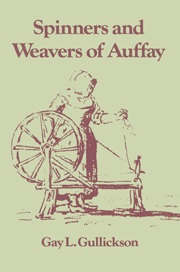 The Spinners and Weavers of Auffay
The Spinners and Weavers of Auffay Book contents
- Frontmatter
- Contents
- Preface
- 1 Introduction
- 2 The pays and the village
- 3 Proto-industrial theory and the pays de Caux
- 4 The golden age of spinning
- 5 Crisis and change in the Caux
- 6 The golden age of cottage weaving
- 7 Marriage and family in proto-industrial Auffay
- 8 Widowhood, remarriage, and the sexual division of labor
- 9 Unwed mothers and their children
- 10 Conclusions: the causes and consequences of proto-industrialization
- Appendix Vital statistics for Auffay
- Notes
- Bibliography
- Index
9 - Unwed mothers and their children
Published online by Cambridge University Press: 29 October 2009
- Frontmatter
- Contents
- Preface
- 1 Introduction
- 2 The pays and the village
- 3 Proto-industrial theory and the pays de Caux
- 4 The golden age of spinning
- 5 Crisis and change in the Caux
- 6 The golden age of cottage weaving
- 7 Marriage and family in proto-industrial Auffay
- 8 Widowhood, remarriage, and the sexual division of labor
- 9 Unwed mothers and their children
- 10 Conclusions: the causes and consequences of proto-industrialization
- Appendix Vital statistics for Auffay
- Notes
- Bibliography
- Index
Summary
When Marguerite Saunier walked down the aisle of the Auffay church in 1777, she was four months pregnant. When her daughter, Marie Marguerite Baudouin, made the same journey thirty years later, she was seven months pregnant. And when her granddaughter, Marguerite Josephine Maillard, married Evariste Sylvain Hallebout in 1833, she was still recovering from the birth of her first child, born five weeks earlier and probably fathered by Hallebout, although we cannot be certain because the child died at birth and there was no need for him to declare his parenthood at the wedding.
At first glance, this may appear to be the story of the moral decline of a family. But although individual experiences and decisions lie behind the pregnancy of every woman, Marie Marguerite Saunier, Marie Marguerite Baudouin, and Marguerite Josephine Maillard were typical of their generations. In the mid-eighteenth century, one-fifth of the women who married in Auffay were pregnant. In the last decade of the century and on into the nineteenth, this number increased to well over one-quarter; while the number of women who bore children out of wedlock increased sixfold from midcentury to midcentury. The reasons for these changes are complex, as were their effects on the Auffay community.
- Type
- Chapter
- Information
- The Spinners and Weavers of AuffayRural Industry and the Sexual Division of Labor in a French Village, pp. 178 - 194Publisher: Cambridge University PressPrint publication year: 1986
